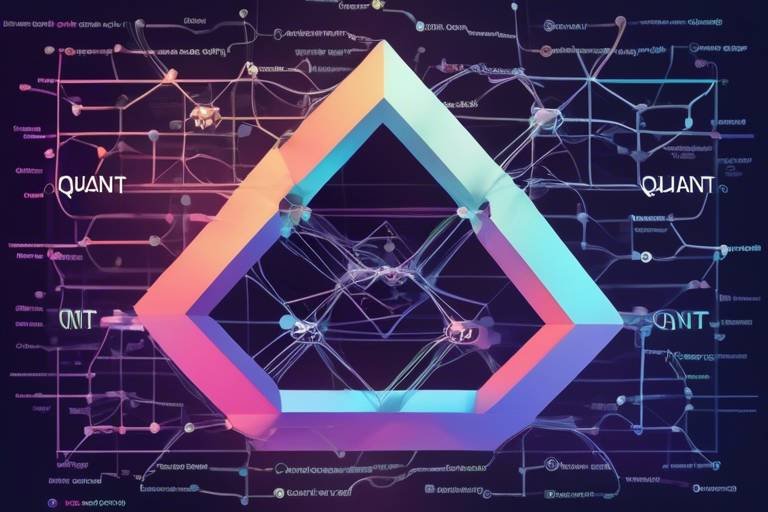Quant (QNT) - The Overledger Network Explained
Welcome to the fascinating world of Quant (QNT) and its groundbreaking Overledger Network! In a digital age where multiple blockchain networks exist, the need for seamless communication between them has never been more critical. Think of the Overledger Network as the universal translator in a world filled with different languages—each blockchain speaking its own dialect. This innovative technology is set to revolutionize how we interact with digital assets, making it easier for businesses and individuals alike to navigate the complex web of blockchain ecosystems. So, what exactly is Quant, and how does it aim to bridge the gap between these diverse networks? Let’s dive in!
Quant is not just another cryptocurrency; it’s a visionary project with a mission to enhance connectivity and interoperability across various blockchain platforms. Founded in 2018, Quant aims to break down the silos that have traditionally separated different blockchains, allowing them to communicate and share data effortlessly. Imagine a world where you can transfer assets from one blockchain to another without the hassle of intermediaries or complicated processes—that’s the dream Quant is working towards! By leveraging its unique Overledger technology, Quant seeks to create a more integrated digital asset space, enabling developers to build decentralized applications (dApps) that can operate across multiple blockchains. This vision is not just about convenience; it’s about unlocking new opportunities for innovation and efficiency in the digital economy.
The Overledger Network is the backbone of Quant’s mission, designed to facilitate seamless communication between various blockchain platforms while ensuring security and efficiency. At its core, Overledger acts as an intermediary layer that connects different blockchains, allowing them to share information and execute transactions without friction. This architecture is crucial in a world where different blockchains serve different purposes, and their interoperability can lead to a more robust blockchain ecosystem. With Overledger, developers can create applications that tap into the unique features of multiple blockchains, opening up a world of possibilities for innovation.
So, what makes Overledger stand out in the crowded blockchain landscape? Let’s explore some of its essential features:
- Multi-Chain Interoperability: Overledger enables different blockchains to communicate and share data, fostering a more integrated digital environment.
- Scalability: The platform supports high transaction volumes, ensuring optimal performance as the demand for blockchain solutions grows.
- Support for Decentralized Applications: Developers can create innovative dApps that leverage the capabilities of various blockchain ecosystems.
Imagine trying to send a message to a friend who speaks a different language. Without a translator, communication would be nearly impossible. That’s the challenge Overledger addresses in the blockchain world. By enabling different blockchains to communicate, Overledger allows for a more cohesive and efficient digital environment. This means that assets can move freely between networks, and applications can harness the strengths of multiple blockchains. It’s like being able to use the best tools for the job, no matter what toolbox they come from!
As more businesses and users flock to blockchain technology, scalability becomes a pressing concern. Overledger tackles this issue head-on by providing solutions that support high transaction volumes. Think of it as widening a road to accommodate more traffic—Overledger ensures that as the demand for blockchain solutions increases, the network can handle it without slowing down. This scalability is crucial for businesses looking to adopt blockchain technology without worrying about performance bottlenecks.
Utilizing Quant’s Overledger comes with a host of advantages for businesses and developers. By leveraging this innovative technology, organizations can reduce costs, increase efficiency, and create groundbreaking applications that were previously unimaginable. The ability to interact with multiple blockchains opens doors to new revenue streams and operational efficiencies, making Overledger a game-changer in the digital asset space.
The true power of the Overledger Network can be seen in its real-world applications. Organizations across various sectors are leveraging its capabilities to enhance their operations and create new value. Let’s take a closer look at some of these use cases.
Financial institutions are among the first to adopt Overledger, recognizing its potential to improve cross-border transactions and streamline processes. By facilitating communication between different blockchain networks, Overledger helps reduce operational risks and costs associated with traditional banking methods. Imagine being able to send money across the globe in seconds, without the hefty fees or delays—this is the future that Overledger promises!
In the realm of supply chain management, Overledger is making waves by enabling better tracking, transparency, and efficiency. With the ability to integrate multiple blockchains, companies can monitor their supply chains in real-time, ensuring that products are sourced ethically and delivered on time. This enhanced visibility not only boosts operational efficiency but also builds trust with consumers who are increasingly concerned about the origins of their products.
As we look to the future, the potential advancements in Quant and the Overledger Network are exciting. With ongoing developments in technology, new partnerships, and a rapidly evolving landscape of blockchain interoperability, the possibilities are endless. As more organizations recognize the importance of interconnected blockchain solutions, Quant is poised to play a pivotal role in shaping the future of the digital economy.
Q: What is Quant (QNT)?
A: Quant is a blockchain technology company that aims to enhance interoperability between different blockchain networks through its Overledger Network.
Q: How does the Overledger Network work?
A: The Overledger Network acts as an intermediary layer that allows different blockchains to communicate and share data, enabling seamless transactions and interactions.
Q: What are the benefits of using Overledger?
A: Benefits include reduced costs, increased efficiency, and the ability to create innovative decentralized applications that leverage multiple blockchain ecosystems.
Q: What industries can benefit from Overledger?
A: Industries such as financial services and supply chain management are already leveraging Overledger to enhance their operations and create new value.
Q: What does the future hold for Quant and Overledger?
A: The future looks promising with potential advancements in technology and new partnerships, as Quant continues to lead the way in blockchain interoperability.

What is Quant (QNT)?
Quant (QNT) is a groundbreaking technology that aims to revolutionize the way we interact with blockchain networks. Imagine a world where different blockchains can communicate seamlessly, just like people from various countries speaking a common language. That’s the vision behind Quant. Founded in 2018 by Gilbert Verdian, Quant's mission is to bridge the gap between disparate blockchain systems, enhancing connectivity and interoperability in the digital asset space.
At its core, Quant focuses on creating a unified framework that allows various blockchain platforms to work together harmoniously. This is particularly important in a landscape where thousands of blockchains exist, each with its unique features and protocols. Without a way to connect these systems, valuable data and opportunities are often locked away, much like a treasure chest with no key. Quant's solution? The Overledger Network, which serves as a layer that enables different blockchains to communicate and share information.
In a world increasingly driven by digital assets, the need for interoperability is more pressing than ever. Quant addresses this need by providing tools and protocols that developers can use to create decentralized applications (dApps) that can operate across multiple blockchain networks. This not only enhances the functionality of these applications but also opens the door to a myriad of possibilities for innovation.
Furthermore, Quant's approach is not just about connecting blockchains; it's about doing so in a way that prioritizes security and efficiency. With the Overledger Network, users can enjoy the benefits of blockchain technology without the usual complications associated with interoperability. In essence, Quant is not just another cryptocurrency; it’s a visionary project aimed at redefining how we think about blockchain technology and its potential.
To summarize, Quant (QNT) is:
- A bridge: Connecting various blockchain networks for enhanced interoperability.
- Innovative: Utilizing the Overledger Network to facilitate seamless communication.
- Future-focused: Aiming to reshape the digital asset landscape through advanced technology.
As we delve deeper into the workings of the Overledger Network, it becomes clear that Quant is positioned at the forefront of blockchain innovation. By enabling diverse blockchain ecosystems to interact, Quant not only enhances the utility of existing technologies but also paves the way for future advancements that could redefine entire industries.

Understanding the Overledger Network
The Overledger Network is a revolutionary framework that serves as the backbone of Quant's mission to achieve blockchain interoperability. Imagine a world where different blockchains can communicate and interact seamlessly, much like how various apps on your smartphone work together to enhance your overall experience. That’s the essence of Overledger—it acts as a bridge, allowing diverse blockchain networks to exchange information and value without the usual barriers that hinder connectivity. This innovative technology is not just about connecting blockchains; it’s about unlocking a new realm of possibilities for decentralized applications (dApps) and digital assets.
At its core, Overledger is designed to facilitate multi-chain interoperability, which means it enables different blockchain systems to work in harmony. Think of it as a universal translator for blockchains, allowing them to share data and functionalities effortlessly. This is crucial in a landscape where numerous blockchain networks exist, each with its own unique features and protocols. The Overledger Network ensures that these diverse ecosystems can coexist and collaborate, ultimately leading to a more integrated digital economy.
The architecture of Overledger is built on several key principles that enhance its functionality. First and foremost, it employs a layered design that separates the application layer from the underlying blockchain networks. This means developers can build applications on top of Overledger without needing to worry about the complexities of each individual blockchain. In essence, it abstracts the intricacies of blockchain technology, making it more accessible for developers and businesses alike. Furthermore, Overledger supports various programming languages and tools, which allows developers to utilize familiar environments while building their dApps.
Another significant aspect of Overledger is its emphasis on security and efficiency. By leveraging advanced cryptographic techniques, Overledger ensures that data transmitted between blockchains remains secure and tamper-proof. This is vital in maintaining trust among users and institutions that rely on blockchain technology for their operations. Additionally, the network is optimized for performance, allowing for rapid transaction processing and minimal latency, which is essential for applications that require real-time data exchange.
In summary, the Overledger Network is a groundbreaking solution that addresses the challenges of blockchain interoperability. By providing a robust framework for seamless communication between different blockchain platforms, it paves the way for a future where decentralized applications can thrive across multiple ecosystems. This capability not only enhances the functionality of individual blockchains but also contributes to the overall growth and maturation of the digital asset landscape.

Key Features of Overledger
When we talk about the Overledger Network, we are diving into a realm of technological sophistication that redefines how different blockchains interact. One of its standout features is multi-chain interoperability, which essentially means that Overledger allows various blockchain networks to communicate and share data seamlessly. Imagine a world where Bitcoin, Ethereum, and other blockchains can exchange information as easily as sending a text message. This capability not only enhances connectivity but also paves the way for a more integrated digital ecosystem.
Another remarkable feature of Overledger is its scalability. As the demand for blockchain solutions continues to surge, Overledger is designed to handle high transaction volumes without breaking a sweat. This scalability ensures that as more users adopt blockchain technology, the performance remains optimal, making it an attractive option for developers looking to build robust decentralized applications. With Overledger, businesses can scale their operations without the fear of bottlenecks or slowdowns.
Moreover, Overledger supports a variety of decentralized applications (dApps) across different blockchain ecosystems. This flexibility is a game-changer for developers who want to create applications that can operate on multiple chains, enhancing their reach and usability. The ability to deploy applications in a multi-chain environment means that developers can tap into different user bases and functionalities, maximizing their potential for innovation.
To summarize, the key features of the Overledger Network can be encapsulated as follows:
- Multi-Chain Interoperability: Facilitates communication between various blockchain platforms.
- Scalability: Ensures optimal performance even with high transaction volumes.
- Support for Diverse dApps: Allows developers to create applications that operate across multiple blockchain networks.
These features not only enhance the functionality of the Overledger Network but also set the stage for a future where blockchain technology is more accessible and integrated into our daily lives. In a world where connectivity is key, Overledger stands out as a beacon of innovation, promising to revolutionize how we think about and use blockchain technology.
- What is Overledger?
Overledger is a multi-chain operating system developed by Quant that enables different blockchains to communicate and share data seamlessly. - How does Overledger achieve multi-chain interoperability?
Overledger uses a unique architecture that allows it to connect different blockchain networks, facilitating easy data exchange. - What are the benefits of using Overledger for developers?
Developers benefit from Overledger through enhanced scalability, reduced costs, and the ability to create innovative applications that operate across multiple chains. - Can Overledger handle high transaction volumes?
Yes, Overledger is designed with scalability in mind, ensuring optimal performance even as transaction demands increase.

Multi-Chain Interoperability
In the ever-evolving world of blockchain technology, one of the most significant challenges has been the lack of communication between different blockchain networks. This is where Quant's Overledger Network shines, offering a revolutionary solution for . Imagine a world where various blockchain platforms can effortlessly share data and interact with one another as if they were all part of the same ecosystem. That’s exactly what Overledger aims to achieve.
At its core, multi-chain interoperability is about breaking down the silos that have historically existed between different blockchains. Each blockchain operates independently, which can lead to inefficiencies and missed opportunities for collaboration. Overledger acts as a bridge, allowing disparate networks to communicate and share information seamlessly. This capability not only enhances connectivity but also opens up new avenues for innovation across industries.
Consider this analogy: think of blockchains as different countries, each with its own language and customs. Without a common language or means of communication, trade and collaboration become challenging. Overledger serves as a universal translator, enabling these 'countries' to interact, share resources, and ultimately create a more integrated global economy. This is particularly crucial in a landscape where businesses are increasingly looking to leverage the unique strengths of multiple blockchains.
With Overledger, developers can build applications that harness the power of various blockchains simultaneously. For instance, a decentralized finance (DeFi) application could utilize Ethereum's smart contract capabilities while also tapping into the security features of Bitcoin. This flexibility allows for the creation of more robust and versatile applications that can adapt to the needs of users across different platforms.
Furthermore, the implications of multi-chain interoperability extend beyond just application development. Businesses can streamline their operations by integrating multiple blockchain solutions, leading to enhanced efficiency and reduced costs. For example, a company could use Overledger to manage supply chain data across different blockchain networks, ensuring that all stakeholders have access to real-time information without the need for complex integrations.
In summary, multi-chain interoperability is a game-changer for the blockchain landscape. By enabling seamless communication between different networks, Quant's Overledger Network not only enhances the functionality of decentralized applications but also fosters a more collaborative and efficient digital ecosystem. As we continue to witness the growth of blockchain technology, the importance of interoperability will only increase, making Overledger an essential tool for businesses and developers alike.

Scalability Solutions
When we talk about scalability in the context of blockchain technology, we're diving into one of the most crucial aspects that can determine a network's success. Quant's Overledger Network is designed with scalability in mind, ensuring that it can handle an increasing number of transactions without compromising on speed or efficiency. Think of it like a highway: the more lanes you have, the more cars can travel simultaneously without getting stuck in traffic. Overledger implements multi-chain architecture that allows it to process transactions across various blockchains, which is essential as the demand for blockchain solutions continues to grow.
One of the standout features of Overledger is its ability to scale horizontally. This means that rather than upgrading the existing infrastructure (which can be costly and time-consuming), Overledger can simply add more nodes to the network. Each new node increases the capacity of the system, allowing for a greater number of transactions to be processed concurrently. This flexibility is vital in a rapidly evolving digital landscape where transaction volumes can spike unexpectedly.
Moreover, Overledger employs a unique consensus mechanism that enhances its scalability. By allowing different blockchains to operate simultaneously while maintaining their individual consensus protocols, Overledger can facilitate faster transaction times. This is akin to having multiple checkout counters open at a grocery store; the more counters there are, the quicker customers can complete their purchases. With Overledger, businesses can expect reduced latency and improved transaction throughput, which are critical for real-time applications.
Another key aspect of Overledger's scalability solutions is its support for multi-chain applications. This capability allows developers to build applications that can interact with multiple blockchains at once, without being tied to a single network. Imagine being able to use a single app to manage assets on Bitcoin, Ethereum, and other blockchains seamlessly. This not only enhances user experience but also opens up a world of possibilities for innovative applications that leverage the strengths of various blockchain technologies.
To summarize, the scalability solutions provided by Quant's Overledger Network are designed to meet the growing demands of the blockchain ecosystem. With horizontal scaling, efficient consensus mechanisms, and support for multi-chain applications, Overledger is paving the way for a more connected and efficient digital future. As businesses continue to explore blockchain technology, the ability to scale effectively will be a game-changer, enabling them to operate more efficiently and innovate at an unprecedented pace.
- What is Quant's Overledger Network?
Overledger is a blockchain operating system that enables different blockchains to connect and communicate with each other, enhancing interoperability. - How does Overledger ensure scalability?
Overledger employs horizontal scaling, allowing the addition of more nodes to handle increased transaction volumes while maintaining speed and efficiency. - Can I build applications on Overledger?
Yes, developers can create multi-chain applications that interact with various blockchains, maximizing functionality and user experience. - What industries can benefit from Overledger?
Overledger is applicable across various industries, including finance, supply chain management, and healthcare, enhancing processes and creating new value.

Benefits of Using Quant's Overledger
When it comes to the world of blockchain, the term "interoperability" often gets thrown around like confetti at a parade. But what does it really mean for businesses and developers? Enter Quant's Overledger, a game-changing solution that not only promises but delivers a seamless bridge between various blockchain networks. The benefits of using Overledger are as compelling as they are numerous, and they can significantly enhance the way organizations operate in the digital landscape.
One of the standout advantages of Overledger is its ability to reduce costs. Traditional blockchain solutions often require extensive resources to maintain multiple networks. With Overledger, businesses can streamline their operations, allowing them to connect multiple blockchains without the need for separate infrastructures. This consolidation not only cuts down on costs but also simplifies the overall management of blockchain assets.
Moreover, Overledger enhances efficiency. Imagine trying to send a message across different languages without a translator; it would be a nightmare, right? Overledger acts as that translator, enabling different blockchains to communicate effortlessly. This means faster transaction times and reduced latency, which is crucial for businesses that operate in real-time environments. When every second counts, having a solution that minimizes delays can be the difference between success and failure.
Another significant benefit is the potential for innovation. With Overledger, developers can create decentralized applications (dApps) that can operate across multiple blockchain platforms. This opens up a world of possibilities, allowing for the development of applications that leverage the unique features of different blockchains. For instance, a dApp could utilize Ethereum’s smart contracts while simultaneously benefiting from the scalability of another blockchain. This flexibility empowers developers to think outside the box and create solutions that were previously unimaginable.
Furthermore, Overledger is designed with security in mind. In a world where data breaches and cyber threats are rampant, ensuring the safety of transactions is paramount. Overledger employs advanced security protocols that protect data integrity while facilitating communication between blockchains. This means that businesses can confidently engage with multiple networks without compromising on security.
Finally, the scalability of Overledger cannot be overlooked. As businesses grow, so does the demand for blockchain solutions. Overledger is built to handle high transaction volumes without sacrificing performance. This scalability ensures that organizations can expand their operations without worrying about their infrastructure becoming a bottleneck.
In summary, the benefits of using Quant's Overledger are substantial and multifaceted. By reducing costs, enhancing efficiency, fostering innovation, ensuring security, and providing scalability, Overledger positions itself as a vital tool for businesses looking to thrive in the ever-evolving digital landscape. As we move forward, it's clear that those who embrace this technology will be better equipped to navigate the complexities of blockchain interoperability.
- What is Quant's Overledger?
Quant's Overledger is a blockchain interoperability platform that allows different blockchain networks to communicate and share data seamlessly.
- How does Overledger enhance security?
Overledger employs advanced security protocols to protect data integrity during transactions across multiple blockchains.
- Can developers build applications on Overledger?
Yes, developers can create decentralized applications that operate across various blockchain platforms using Overledger.
- What are the cost benefits of using Overledger?
Overledger reduces operational costs by consolidating multiple blockchain networks into a single infrastructure, simplifying management.
- Is Overledger scalable?
Absolutely! Overledger is designed to handle high transaction volumes, making it suitable for businesses of all sizes.

Real-World Applications
The Overledger Network is not just a theoretical construct; it has found its way into various industries, showcasing its versatility and potential to revolutionize how we interact with blockchain technology. From financial services to supply chain management, the real-world applications of Quant's Overledger are both diverse and impactful. Let's explore some of these exciting use cases that highlight the network's capabilities and the benefits it brings to different sectors.
In the realm of financial services, institutions are increasingly turning to the Overledger Network to streamline operations and enhance transaction efficiency. Imagine a world where cross-border transactions happen in the blink of an eye, without the usual delays and exorbitant fees. With Overledger, financial institutions can facilitate seamless communication between different blockchain networks, allowing for faster, cheaper, and more secure transactions. This capability not only reduces operational risks but also opens up new avenues for innovation, enabling the development of decentralized finance (DeFi) applications that can cater to a global audience.
Furthermore, the Overledger Network is making waves in supply chain management. In an industry where transparency and traceability are paramount, Overledger provides a solution that enhances tracking capabilities across various blockchain platforms. Companies can now monitor their products from origin to consumer, ensuring that every step of the supply chain is recorded and verifiable. This level of transparency not only builds trust with consumers but also helps businesses identify inefficiencies and reduce costs. For example, consider a food supplier who can verify the journey of their products, ensuring they meet safety standards and are delivered fresh. This capability is invaluable in today's market, where consumers demand accountability.
Moreover, the flexibility of Overledger allows it to support a myriad of decentralized applications (dApps) across different industries. Whether it’s healthcare, real estate, or gaming, developers can leverage Overledger’s multi-chain interoperability to create applications that operate seamlessly across various blockchain networks. This means that users can enjoy a more integrated experience, with applications that can communicate and share data without the usual barriers posed by different blockchain ecosystems. For instance, a healthcare application can securely share patient data across multiple healthcare providers, ensuring that patients receive the best care without compromising their privacy.
As we look to the future, the possibilities for Overledger's real-world applications seem limitless. The combination of multi-chain interoperability, enhanced security, and scalability solutions positions Quant's Overledger Network as a key player in the ongoing evolution of blockchain technology. By bridging the gaps between different networks, Overledger not only enhances operational efficiencies but also empowers businesses to innovate and create value in ways that were previously unimaginable.
- What is the Overledger Network?
The Overledger Network is a multi-chain platform developed by Quant that facilitates interoperability between different blockchain networks, enabling seamless communication and data sharing. - How does Overledger benefit financial institutions?
Overledger allows financial institutions to streamline cross-border transactions, reduce operational risks, and enhance efficiency by enabling communication between various blockchain networks. - Can Overledger be used in industries other than finance?
Yes, Overledger is versatile and can be applied in various sectors, including supply chain management, healthcare, real estate, and gaming. - What are the key features of Overledger?
Key features include multi-chain interoperability, scalability, and support for decentralized applications across different blockchain ecosystems.

Financial Services
The financial services industry is experiencing a seismic shift, and at the heart of this transformation is Quant's Overledger Network. Imagine a world where banks, payment processors, and digital asset platforms can communicate effortlessly, breaking down the silos that have long plagued the financial sector. With Overledger, this dream is becoming a reality, allowing for enhanced cross-border transactions and streamlined processes that not only save time but also reduce operational risks.
One of the standout features of Overledger is its ability to facilitate multi-chain interoperability. This means that various blockchain networks can exchange data and value seamlessly. For financial institutions, this is a game-changer. For instance, a bank operating on one blockchain can easily transact with another bank on a different blockchain without the need for cumbersome intermediaries. This not only speeds up transactions but also significantly cuts costs associated with cross-border payments.
Moreover, Overledger's architecture supports smart contracts that can automate various financial processes. Think about it: instead of manually verifying transactions or contracts, smart contracts can execute automatically when predefined conditions are met. This automation reduces human error and enhances trust among parties involved in a transaction. Financial institutions can leverage these capabilities to create innovative products and services that cater to the evolving needs of their clients.
To illustrate the impact of Overledger on financial services, consider the following key benefits:
- Faster Transactions: With Overledger, transactions can occur in real-time, eliminating the delays commonly associated with traditional banking systems.
- Cost Efficiency: By reducing the need for intermediaries, financial institutions can lower transaction costs, benefiting both the banks and their customers.
- Enhanced Security: Overledger employs robust security protocols that ensure the integrity and confidentiality of transactions, making it a reliable choice for financial applications.
As the demand for digital financial solutions grows, institutions that embrace Overledger stand to gain a competitive edge. By adopting this innovative technology, they can not only improve their operational efficiencies but also offer new services that meet the expectations of a tech-savvy clientele. In a landscape where agility and adaptability are crucial, Quant's Overledger Network is paving the way for a more integrated and efficient financial ecosystem.
Q1: What is Quant's Overledger Network?
A1: Quant's Overledger Network is a platform designed to facilitate interoperability between different blockchain networks, allowing for seamless communication and data exchange.
Q2: How does Overledger benefit financial institutions?
A2: Overledger provides faster transactions, cost efficiency by reducing intermediaries, and enhanced security for financial operations.
Q3: Can Overledger support smart contracts?
A3: Yes, Overledger supports smart contracts, enabling automated execution of transactions and processes based on predefined conditions.
Q4: What industries can benefit from Overledger?
A4: While financial services are a primary focus, Overledger can also benefit industries such as supply chain management, healthcare, and more, by enhancing connectivity and efficiency.

Supply Chain Management
In today's fast-paced and interconnected world, effective supply chain management is crucial for businesses aiming to maintain a competitive edge. The integration of Quant's Overledger Network into supply chain processes is revolutionizing how organizations track and manage their goods. Imagine a world where every transaction, from the moment a product is manufactured to its final delivery, is seamlessly recorded and accessible across various blockchain platforms. This is the promise of Overledger, enabling a level of transparency and efficiency that was previously unimaginable.
One of the standout features of Overledger is its ability to facilitate real-time data sharing between different blockchain networks. This means that stakeholders—from manufacturers to retailers—can access accurate and up-to-date information about their products at any given moment. For instance, if a shipment is delayed, all parties involved can be instantly notified, allowing them to make informed decisions without the usual bottlenecks associated with traditional systems. This level of transparency not only enhances trust among participants but also significantly reduces operational risks.
Moreover, the Overledger Network supports the creation of decentralized applications (dApps) specifically designed for supply chain management. These applications can automate processes such as inventory tracking, order fulfillment, and compliance checks, leading to greater efficiency and reduced costs. For example, a dApp could automatically verify the authenticity of a product by checking its history across multiple blockchains, ensuring that consumers receive genuine goods. This is especially important in industries plagued by counterfeiting, such as pharmaceuticals or luxury goods.
To illustrate the impact of Overledger on supply chain management, consider the following table:
| Feature | Benefit |
|---|---|
| Real-time Tracking | Improved visibility and reduced delays |
| Decentralized Applications | Automation of processes and reduced human error |
| Cross-Blockchain Communication | Enhanced collaboration between different entities |
| Data Integrity | Increased trust through immutable records |
Furthermore, the scalability of the Overledger Network means that it can handle a growing volume of transactions as businesses expand. As supply chains become more complex with globalization, the ability to scale operations without compromising performance is invaluable. This adaptability ensures that companies can respond to market demands swiftly, without the fear of system overloads or failures.
In conclusion, the integration of Quant's Overledger Network into supply chain management represents a significant leap forward in how businesses operate. By enhancing transparency, improving efficiency, and fostering collaboration, Overledger is not just a tool for managing supply chains; it is a transformative technology that can redefine the entire landscape of logistics and distribution. As organizations continue to embrace this innovative approach, the future of supply chain management looks brighter than ever.
- What is Quant's Overledger Network?
Quant's Overledger Network is a multi-chain platform that enables different blockchain networks to communicate and share data seamlessly. - How does Overledger improve supply chain management?
Overledger enhances supply chain management by providing real-time tracking, automating processes through dApps, and ensuring data integrity across multiple blockchains. - Can Overledger handle high transaction volumes?
Yes, Overledger is designed to be scalable, allowing it to handle increasing transaction volumes as businesses grow. - Is Overledger secure?
Overledger maintains high security standards, ensuring that data shared across networks is protected and immutable.

The Future of Quant and Overledger
The future of Quant and its Overledger Network is poised to be a thrilling journey into the realm of blockchain interoperability. As technology continues to evolve at a breakneck pace, Quant stands at the forefront, ready to capitalize on emerging trends and demands in the digital asset space. Imagine a world where different blockchain networks can seamlessly communicate with one another, much like how smartphones connect to the internet—this is the vision that Quant is working towards.
Looking ahead, we can expect several key developments that will shape the destiny of Quant and Overledger. For starters, partnerships with major technology firms and financial institutions are likely to expand. These collaborations could provide the necessary resources and expertise to enhance the Overledger's capabilities, making it even more robust and versatile. Think of it as a powerful orchestra, where each musician (partner) contributes to a harmonious symphony of blockchain solutions.
Moreover, advancements in technology will play a crucial role. With the rise of Web 3.0, decentralized applications (dApps) are becoming increasingly popular. Overledger is already equipped to support these applications across multiple blockchains, and as more developers recognize its potential, we can anticipate a surge in innovative projects. This could lead to a new wave of applications that leverage the strengths of various blockchains, creating an ecosystem that is not only efficient but also rich in functionality.
Another exciting prospect is the potential for regulatory advancements. As governments around the world begin to understand and embrace blockchain technology, clearer regulations could emerge. This would provide a safer environment for businesses to operate, fostering greater adoption of Quant's Overledger Network. Imagine a clear roadmap guiding businesses through the complex landscape of blockchain compliance—this is what could be on the horizon.
In addition to partnerships and technology, scalability will be a focal point for Quant. As the demand for blockchain solutions grows, Overledger’s ability to handle high transaction volumes efficiently will be paramount. The team behind Quant is likely to invest in further enhancing scalability, ensuring that the network can support a growing number of users and applications without compromising on speed or security.
Finally, the concept of interoperability itself is evolving. As more blockchains enter the market, the need for a universal solution that connects them all will become increasingly critical. Quant's Overledger is uniquely positioned to address this need, acting as a bridge that unites diverse blockchain ecosystems. This vision of interconnected networks could redefine how we think about digital assets, creating a more integrated and efficient digital economy.
In conclusion, the future of Quant and the Overledger Network is not just about technological advancements; it's about creating a cohesive digital environment where innovation thrives. With the right partnerships, technological enhancements, and a focus on scalability and interoperability, Quant could very well lead the charge into a new era of blockchain connectivity.
- What is Quant's Overledger Network?
Overledger is a multi-chain network that facilitates communication between different blockchain platforms, enabling interoperability and supporting decentralized applications. - How does Quant enhance blockchain interoperability?
Quant’s Overledger allows various blockchains to share data and communicate seamlessly, breaking down silos and creating a more integrated digital environment. - What industries can benefit from Overledger?
Overledger can be applied across various sectors, including finance, supply chain management, healthcare, and many more, improving efficiency and transparency. - What are the future prospects for Quant?
The future looks bright for Quant, with anticipated advancements in technology, regulatory clarity, and increased adoption of decentralized applications.
Frequently Asked Questions
- What is Quant (QNT)?
Quant (QNT) is a blockchain technology company focused on enhancing interoperability between different blockchain networks. Its mission is to bridge the gaps between these networks, allowing for seamless communication and data exchange in the digital asset space.
- How does the Overledger Network work?
The Overledger Network operates as a layer that connects multiple blockchains, facilitating interaction and data sharing among them. It employs a unique architecture that ensures security and efficiency while enabling decentralized applications to function across various blockchain ecosystems.
- What are the key features of Overledger?
Overledger boasts several essential features, including multi-chain interoperability, scalability, and support for various decentralized applications. This allows developers to create applications that can operate across different blockchain platforms without being limited to a single network.
- How does Overledger ensure multi-chain interoperability?
Overledger enables different blockchains to communicate by using a standardized protocol, which allows for data sharing and interaction between diverse blockchain networks. This integration fosters a more cohesive digital environment where various applications can thrive.
- What scalability solutions does Overledger provide?
Overledger incorporates scalability features that handle high transaction volumes effectively. This ensures optimal performance as the demand for blockchain solutions increases, allowing businesses to grow without facing bottlenecks.
- What benefits does Quant's Overledger offer to businesses?
Utilizing Overledger provides numerous advantages, including reduced operational costs, increased efficiency, and the ability to create innovative applications that leverage the strengths of multiple blockchains, ultimately driving better business outcomes.
- Can you give examples of real-world applications of Overledger?
Yes! Overledger is being used in various sectors, such as financial services, where it enhances cross-border transactions, and in supply chain management, where it improves tracking and transparency, showcasing its versatility across industries.
- What is the future of Quant and Overledger?
The future of Quant and the Overledger Network looks promising, with potential advancements in technology and new partnerships on the horizon. As blockchain interoperability continues to evolve, Quant aims to remain at the forefront of these developments.



















